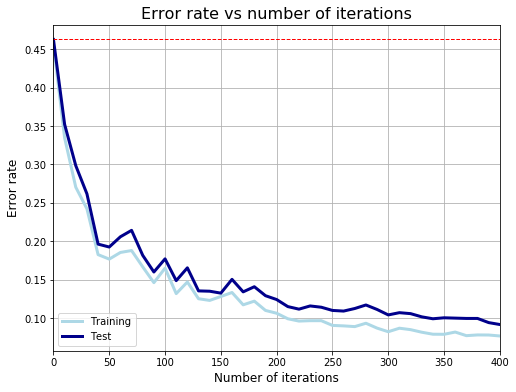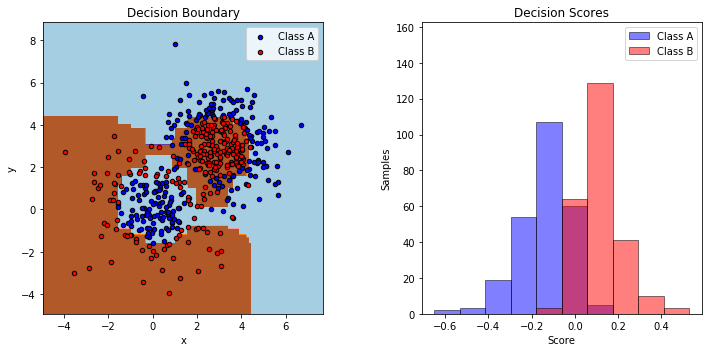所属知识点:Machine Learning:Boosting
归纳和总结机器学习技术的库:ViolinLee/ML_notes。该库主要内容是我的机器学习笔记,同时挑选和收集各类与机器学习技术相关的高质量资源,欢迎大家关注和Star!会一直更新下去。
微信公众号:“RoboticsCV”(微信号:ModernRobotics)。公众号专注机器人学,关注机器学习、计算机视觉等前沿技术在机器人领域中的应用。公众号将分享与机器人相关的重要知识和前沿技术,同时保证文章的质量,对总结和分享的各个技术,尽量做到在概念,项目,学习资源上都对大家有充分帮助。公众号刚注册,很快会运营,欢迎大家关注!
AdaBoost(Adaptive Boosting,自适应增强)属于提升方法(Boosting)的一种,由Yoav Freund和Robert Schapire提出。AdaBoost方法的自适应在于:前一个分类器分错的样本会被用来训练下一个分类器。AdaBoost 方法对于噪声数据和异常数据很敏感。但在一些问题中,AdaBoost 方法相对于大多数其它学习算法而言,不会很容易出现过拟合现象。
注意:AdaBoost 方法中使用的分类器可能很弱(比如出现很大错误率),但只要它的分类效果比随机好一点(比如两类问题分类错误率略小于0.5),就能够改善最终得到的模型。而错误率高于随机分类器的弱分类器也是有用的,因为在最终得到的多个分类器的线性组合中,可以给它们赋予负系数,同样也能提升分类效果。
1. Adaboost 原理
AdaBoost 方法是一种迭代算法,在每一轮中加入一个新的弱分类器,直到达到某个预定的足够小的错误率。每一个训练样本都被赋予一个权重,表明它被某个分类器选入训练集的概率。如果某个样本点已经被准确地分类,那么在构造下一个训练集中,它被选中的概率就被降低;相反,如果某个样本点没有被准确地分类,那么它的权重就得到提高。通过这样的方式,AdaBoost 方法能“聚焦于”那些较难分(更富信息)的样本上。
具体实现:
(1)初始化训练数据(每个样本)的权值分布:最初令每个样本的权重都相等。
(2)训练弱分类器:对于第k次迭代操作,我们就根据每个样本的权重来选取样本点,进而训练分类器。然后根据这个分类器,提高被它错误分类的样本的权重,并降低被正确分类的样本权重。然后,权重更新过的样本集被用于训练下一个分类器
。整个训练过程如此迭代地进行下去。
(3)将各个训练得到的弱分类器组合成强分类器:各个弱分类器的训练过程结束后,分类误差率小的弱分类器的话语权较大,其在最终的分类函数中起着较大的决定作用,而分类误差率大的弱分类器的话语权较小,其在最终的分类函数中起着较小的决定作用。换言之,误差率低的弱分类器在最终分类器中占的比例较大,反之较小。
关键概念:
迭代算法;每个样本的权重;弱分类器的话语权(权重);
2. Adaboost 优劣
优点
1) Adaboost 是一种高精度分类器
2) Adaboost 算法提供的是框架,因此可以使用各种方法构建子分类器
3) 当使用简单分类器时,计算出的结果是可以理解的。而且弱分类器构造极其简单
4) 简单,不需要做特征筛选
5) 不容易出现过拟合
缺点
1) 对噪声敏感,但这亦是大部分算法的缺点
2) 训练时间长
3) 执行效果依赖于弱分类器的选择
3. Adaboost 算法流程
迭代过程:

图解:

数学描述:
第一步:初始化训练数据的权值分布。
![]()
其中, 表示第一次迭代时每个样本的权值,
表示第一次迭代时第一个样本的权值,
为样本总数。
第二步:进行 M 次迭代。
a) 使用拥有权值分布 的训练样本进行学习,得到弱分类器:
。
弱分类器的性能指标通过以下误差函数的值 来衡量:
b) 计算弱分类器 的话语权
(亦是权值),它表示
在最终分类器中的重要程度。计算方法如下:
![]()
随着 减小,
逐渐增大。该式表明,误差率小的分类器,在最终分类器中的重要程度大。
c) 更新训练样本的权值分布,用于下一轮迭代。被错误分类的样本权值增加;被正确分类的样本权值减小。计算方法如下:
其中, 是用于下次迭代时样本的权值,
是下一次迭代时,第
个样本的权值。
代表第
个样本对应的类别(1 或 -1),
表示弱分类器对样本
的分类(1 或 -1)。若分类正确,则
的值为1,反之为-1。其中
是归一化因子,计算方法如下:
![]()
第三步:组合弱分类器,获得强分类器
首先,对所有迭代过的分类器加权求和:
接着,将 sign 函数作用于求和结果,得到最终的强分类器 :
sign 函数(符号函数,简称 sgn):是一个逻辑函数,用以判断实数的正负号。其定义为:
4. Adaboost 代码实现
4.1 Python 实现
借助 SKlearn 内置的数据集、基础分类器(决策树)、交叉验证函数,使用 Python 实现 Adaboost。以下为实现代码:
adaboost_implementation.ipynb (基于 python 2.7;scikit-learn v0.20.2)
import pandas as pd
import numpy as np
from sklearn.tree import DecisionTreeClassifier
from sklearn.model_selection import train_test_split
from sklearn.datasets import make_hastie_10_2
import matplotlib.pyplot as plt
""" HELPER FUNCTION: GET ERROR RATE ========================================="""
def get_error_rate(pred, Y):
return sum(pred != Y) / float(len(Y))
""" HELPER FUNCTION: PRINT ERROR RATE ======================================="""
def print_error_rate(err):
print 'Error rate: Training: %.4f - Test: %.4f' % err
""" HELPER FUNCTION: GENERIC CLASSIFIER ====================================="""
def generic_clf(Y_train, X_train, Y_test, X_test, clf):
clf.fit(X_train,Y_train)
pred_train = clf.predict(X_train)
pred_test = clf.predict(X_test)
return get_error_rate(pred_train, Y_train), \
get_error_rate(pred_test, Y_test)
""" ADABOOST IMPLEMENTATION ================================================="""
def adaboost_clf(Y_train, X_train, Y_test, X_test, M, clf):
n_train, n_test = len(X_train), len(X_test)
# Initialize weights
w = np.ones(n_train) / n_train
pred_train, pred_test = [np.zeros(n_train), np.zeros(n_test)]
for i in range(M):
# Fit a classifier with the specific weights
clf.fit(X_train, Y_train, sample_weight = w)
pred_train_i = clf.predict(X_train)
pred_test_i = clf.predict(X_test)
# Indicator function
miss = [int(x) for x in (pred_train_i != Y_train)]
# Equivalent with 1/-1 to update weights
miss2 = [x if x==1 else -1 for x in miss]
# Error
err_m = np.dot(w,miss) / sum(w)
# Alpha
alpha_m = 0.5 * np.log( (1 - err_m) / float(err_m))
# New weights
w = np.multiply(w, np.exp([float(x) * alpha_m for x in miss2]))
# Add to prediction
pred_train = [sum(x) for x in zip(pred_train,
[x * alpha_m for x in pred_train_i])]
pred_test = [sum(x) for x in zip(pred_test,
[x * alpha_m for x in pred_test_i])]
pred_train, pred_test = np.sign(pred_train), np.sign(pred_test)
# Return error rate in train and test set
return get_error_rate(pred_train, Y_train), \
get_error_rate(pred_test, Y_test)
""" PLOT FUNCTION ==========================================================="""
def plot_error_rate(er_train, er_test):
df_error = pd.DataFrame([er_train, er_test]).T
df_error.columns = ['Training', 'Test']
plot1 = df_error.plot(linewidth = 3, figsize = (8,6),
color = ['lightblue', 'darkblue'], grid = True)
plot1.set_xlabel('Number of iterations', fontsize = 12)
plot1.set_xticklabels(range(0,450,50))
plot1.set_ylabel('Error rate', fontsize = 12)
plot1.set_title('Error rate vs number of iterations', fontsize = 16)
plt.axhline(y=er_test[0], linewidth=1, color = 'red', ls = 'dashed')
""" MAIN SCRIPT ============================================================="""
if __name__ == '__main__':
# Read data
x, y = make_hastie_10_2()
df = pd.DataFrame(x)
df['Y'] = y
# Split into training and test set
train, test = train_test_split(df, test_size = 0.2)
X_train, Y_train = train.ix[:,:-1], train.ix[:,-1]
X_test, Y_test = test.ix[:,:-1], test.ix[:,-1]
# Fit a simple decision tree first
clf_tree = DecisionTreeClassifier(max_depth = 1, random_state = 1)
er_tree = generic_clf(Y_train, X_train, Y_test, X_test, clf_tree)
# Fit Adaboost classifier using a decision tree as base estimator
# Test with different number of iterations
er_train, er_test = [er_tree[0]], [er_tree[1]]
x_range = range(10, 410, 10)
for i in x_range:
er_i = adaboost_clf(Y_train, X_train, Y_test, X_test, i, clf_tree)
er_train.append(er_i[0])
er_test.append(er_i[1])
# Compare error rate vs number of iterations
plot_error_rate(er_train, er_test)训练曲线:

4.2 调用 Scikit Learn 的 AdaBoostClassifier 函数
例子来自 Two-class AdaBoost 。
print(__doc__)
# Author: Noel Dawe <noel.dawe@gmail.com>
#
# License: BSD 3 clause
import numpy as np
import matplotlib.pyplot as plt
from sklearn.ensemble import AdaBoostClassifier
from sklearn.tree import DecisionTreeClassifier
from sklearn.datasets import make_gaussian_quantiles
# Construct dataset
X1, y1 = make_gaussian_quantiles(cov=2.,
n_samples=200, n_features=2,
n_classes=2, random_state=1)
X2, y2 = make_gaussian_quantiles(mean=(3, 3), cov=1.5,
n_samples=300, n_features=2,
n_classes=2, random_state=1)
X = np.concatenate((X1, X2))
y = np.concatenate((y1, - y2 + 1))
# Create and fit an AdaBoosted decision tree
bdt = AdaBoostClassifier(DecisionTreeClassifier(max_depth=1),
algorithm="SAMME",
n_estimators=200)
bdt.fit(X, y)
plot_colors = "br"
plot_step = 0.02
class_names = "AB"
plt.figure(figsize=(10, 5))
# Plot the decision boundaries
plt.subplot(121)
x_min, x_max = X[:, 0].min() - 1, X[:, 0].max() + 1
y_min, y_max = X[:, 1].min() - 1, X[:, 1].max() + 1
xx, yy = np.meshgrid(np.arange(x_min, x_max, plot_step),
np.arange(y_min, y_max, plot_step))
Z = bdt.predict(np.c_[xx.ravel(), yy.ravel()])
Z = Z.reshape(xx.shape)
cs = plt.contourf(xx, yy, Z, cmap=plt.cm.Paired)
plt.axis("tight")
# Plot the training points
for i, n, c in zip(range(2), class_names, plot_colors):
idx = np.where(y == i)
plt.scatter(X[idx, 0], X[idx, 1],
c=c, cmap=plt.cm.Paired,
s=20, edgecolor='k',
label="Class %s" % n)
plt.xlim(x_min, x_max)
plt.ylim(y_min, y_max)
plt.legend(loc='upper right')
plt.xlabel('x')
plt.ylabel('y')
plt.title('Decision Boundary')
# Plot the two-class decision scores
twoclass_output = bdt.decision_function(X)
plot_range = (twoclass_output.min(), twoclass_output.max())
plt.subplot(122)
for i, n, c in zip(range(2), class_names, plot_colors):
plt.hist(twoclass_output[y == i],
bins=10,
range=plot_range,
facecolor=c,
label='Class %s' % n,
alpha=.5,
edgecolor='k')
x1, x2, y1, y2 = plt.axis()
plt.axis((x1, x2, y1, y2 * 1.2))
plt.legend(loc='upper right')
plt.ylabel('Samples')
plt.xlabel('Score')
plt.title('Decision Scores')
plt.tight_layout()
plt.subplots_adjust(wspace=0.35)
plt.show()运行代码,获得的决策边界和得分情况如以下两幅图所示:

参考和拓展:
李航:《统计学习方法》;lihang_algorithms
Adaboost入门教程——最通俗易懂的原理介绍(图文实例) AdaboostExample
Machine-Learning-in-Action-Python3:《机器学习实战》python3 源码
adaboost:Simple Python Adaboost Implementation
adaboost-implementation:Implementation of AdaBoost algorithm in Python
AdaBoost:Small and easy C++ AdaBoost Implementation
FaceDetection:Human Face Detection based on AdaBoost
Naive_Bayes_Meet_Adaboost:Implement Naive Bayes and Adaboost from scratch and use them filter spam emails.























 2543
2543

 被折叠的 条评论
为什么被折叠?
被折叠的 条评论
为什么被折叠?








